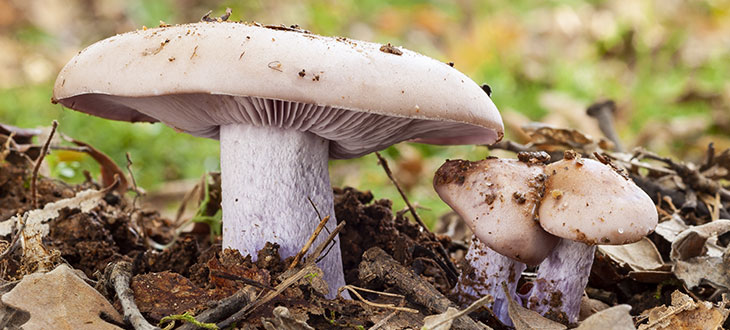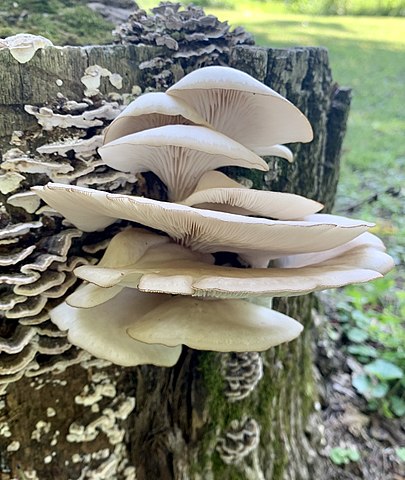10 White Mushroom Species
Have you found one or more white mushrooms and need help identifying them? Here’s a list of 10 species of white mushrooms.
Mushrooms are the fruiting bodies of fungi, and they are neither plants nor animals, but belong to a separate kingdom.
Unlike plants, fungi do not have chlorophyll and are therefore unable to process their food through photosynthesis.
Although there are many species of parasitic mushrooms that grow on live trees or other plants, causing them various forms of rots and diseases, there are also many beneficial fungi that play an essential role in the decomposition of dead plants and animals.
Across the world, there is a wide variety of mushrooms, varying greatly in shape, color, and appearance from one species to another.
The most common colors of mushrooms include white, yellow, red, orange, brown, or variations of these colors.
Today we will talk about some of the most common species of white mushrooms that you can find in various places, such as your yard, in the woods, or even on supermarket shelves.
Important: The information regarding the toxicity of each species of mushroom presented in this article was extracted from diverse sources, which may or may not be correct. The role of this article is not to inform you whether these mushrooms are edible or not but to give you a starting point in identifying the white mushroom species.
Never eat mushrooms that you cannot identify precisely and don’t know for sure if they are edible. Simply because a mushroom species is marked as “Non-Toxic” or “Non-Poisonous,” doesn’t automatically mean it is edible and safe for consumption.
As a side note, we want to specify that the author of this article is not a mycologist. Therefore, we cannot guarantee the accuracy of the information about each mushroom species presented.
Below is a list of several species of mushrooms that stand out through their white color.
Contents
- 1. Button Mushroom (Agaricus Bisporus)
- 2. Oyster Mushroom (Pleurotus Ostreatus)
- 3. Common Puffball (Lycoperdon Perlatum)
- 4. Lion’s Mane (Hericium Erinaceus)
- 5. White Dapperling (Leucoagaricus Leucothites)
- 6. Destroying Angel (Amanita Bisporigera)
- 7. Shaggy Mane (Coprinus Comatus)
- 8. False Parasol (Chlorophyllum Molybdites)
- 9. Milk-white Brittlegill (Russula Delica)
- 10. Frosty Bonnet (Mycena Adscendens)
1. Button Mushroom (Agaricus Bisporus)
| Scientific Name | Agaricus bisporus |
| Common Name | Button mushroom, common mushroom, white mushroom, table mushroom, cultivated mushroom, champignon |
| Family | Agaricaceae |
| Toxicity | Non-Toxic |
Button mushroom (Agaricus bisporus) is an edible mushroom in the family Agaricaceae. It is native to North America and Europe. Some of its other common names include common mushroom, champignon, table mushroom, white mushroom, or cultivated mushroom.

It may look familiar because you may have seen it on the shelves of supermarkets. Agaricus bisporus is one of the most widely cultivated and consumed mushrooms in the world.
It has the classic shape of a mushroom, being composed of a cap with gills underside and supported by a leg.
The color of the cap is white when the mushroom is young and turns light brown at maturity. It is first hemispherical in shape before flattening out.
The gills are crowded, free from the stipe, and initially have a pink color, then turn red-brown and eventually dark brown when the mushroom ages.
The stipe (leg) is white, has a cylindrical shape, and typically bears a thick and narrow ring on the upper side.
2. Oyster Mushroom (Pleurotus Ostreatus)
| Scientific Name | Pleurotus ostreatus |
| Common Name | Oyster mushroom, oyster fungus, hiratake |
| Family | Pleurotaceae |
| Toxicity | Non-Toxic |
The oyster mushroom (Pleurotus ostreatus) is an edible species of mushroom in the family Pleurotaceae. It is widespread in numerous temperate and subtropical forests throughout the world.
Pleurotus ostreatus is a mushroom species that is common both in the wild but also in cultivation, being grown commercially around the world.
This mushroom has a broad, smooth cap in the shape of a fan or oyster, hence its common name, the “oyster mushroom.” Its color can be white, gray, tan, or dark brown.
The cap’s margins are inrolled or wavy, depending on the age of the mushroom.
On the underside, it has white to cream gills that descend on the stipe when present (often absent).
3. Common Puffball (Lycoperdon Perlatum)
| Scientific Name | Lycoperdon perlatum |
| Common Name | Common puffball, warted puffball, gem-studded puffball, wolf farts, devil’s snuff-box |
| Family | Agaricaceae |
| Toxicity | Non-Toxic |
Common puffball (Lycoperdon perlatum) is a species of puffball fungus in the family Agaricaceae. It is found throughout the world, mostly in woodlands, grassy fields, and along roadsides. They may grow in groups, separately, scattered, or in clusters.
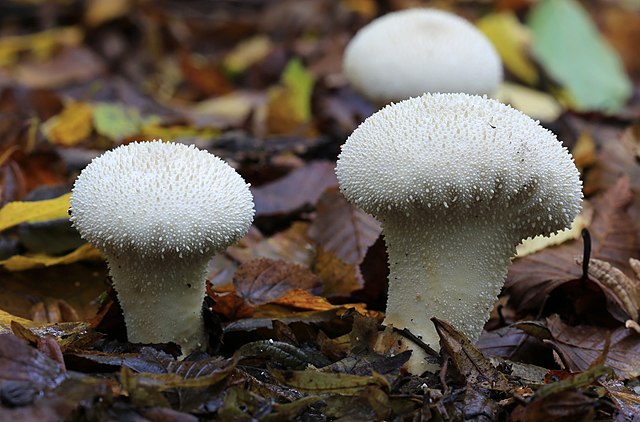
These mushrooms are also commonly known as warted puffballs, wolf farts, gem-studded puffballs, or the devil’s snuff-box.
Lycoperdon perlatum has a pretty distinctive look due to the shape of its fruiting body. This may vary in shape from pear-like with a flattened top, to almost spherical, with a stalk-like base.
When young, the fruiting body is white and coated with conical spiny bumps. Later, when maturing, it becomes brownish and forms a hole at the top through which it discharges spores in a burst when the body is compressed or hit.
Lycoperdon perlatum is generally considered edible when the mushroom is young and white.
4. Lion’s Mane (Hericium Erinaceus)
| Scientific Name | Hericium erinaceus |
| Common Name | Lion’s mane mushroom, mountain-priest mushroom, bearded tooth fungus |
| Family | Hericiaceae |
| Toxicity | Non-Toxic |
Lion’s mane (Hericium erinaceus) is a mushroom in the family Hericiaceae, Native to North America, Asia, and Europe. It is also known as the mountain-priest mushroom or bearded tooth fungus.
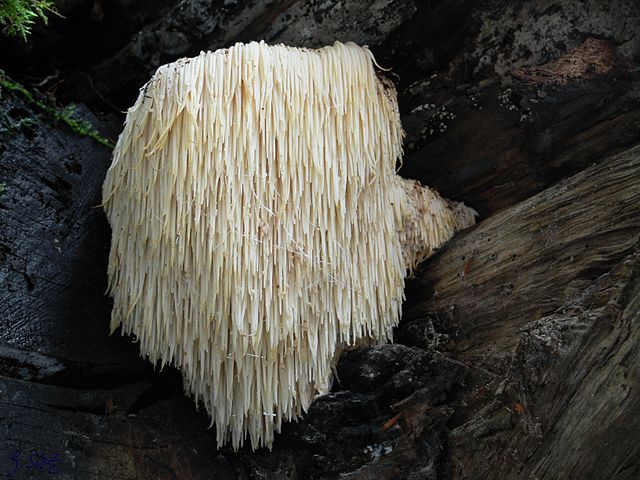
This mushroom grows either as parasitic on living trees or on dead trees as saprophytic.
The fruit bodies of this fungus are composed of white-to-cream crowded, hanging, spore-producing spines. It is similar in look to a lion’s mane, hence its popular name, “lion’s mane mushroom.”
These mushrooms can emerge multiple years on the same tree, including on the dead ones.
Hericium erinaceus is generally considered an edible species.
5. White Dapperling (Leucoagaricus Leucothites)
| Scientific Name | Leucoagaricus leucothites |
| Common Name | White dapperling, white Agaricus mushroom |
| Family | Agaricaceae |
| Toxicity | Unknown |
The white dapperling (Leucoagaricus leucothites) is a mushroom in the family Agaricaceae, widespread in many countries of the world.
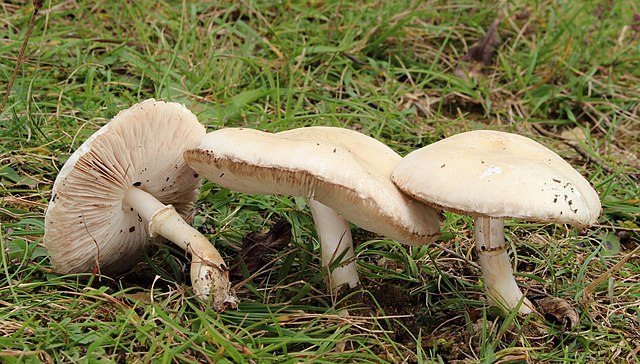
This mushroom is mostly found in grasslands, woods, and even in lawns, where usually grows in scattered groups.
It is composed of a white-to-cream cap with a dull, soft surface and sometimes with tiny scales. It may get a brownish color when aging.
The cap initially has a rounded shape and later becomes convex with a flattened or depressed center.
On the underside of the cap, it has crowded gills, not attached to the stipe. These are white when the mushroom is young and may become cream or light pink at maturity.
The cap is supported by a hollow white leg that is wider at the base. In time, the stem may get a brownish shade.
The edibility of Leucoagaricus leucothites is not clear. While some sources label it as edible, others claim it to be inedible and mildly toxic, causing gastrointestinal problems.
6. Destroying Angel (Amanita Bisporigera)
| Scientific Name | Amanita bisporigera |
| Common Name | Destroying angel, eastern destroying angel amanita, eastern North American destroying angel |
| Family | Amanitaceae |
| Toxicity | Highly-Toxic |
Destroying angel (Amanita bisporigera) is a highly poisonous wild mushroom in the family Amanitaceae. It is widely distributed in eastern North America and frequently found growing on the ground of mixed coniferous and deciduous forests.
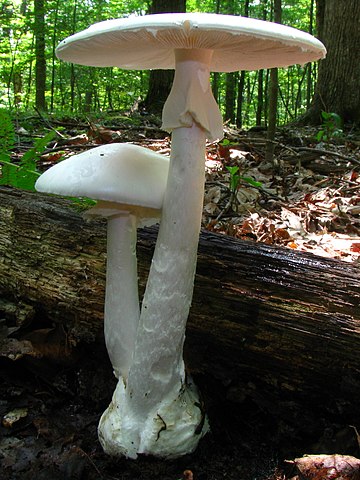
Amanita bisporigera is extremely poisonous and can cause fatal liver failures within several days of consumption.
The body of the mushroom is formed by a curved-to-flat, white cap, with a central swelling. On the underside, it has crowded white gills which can be free from the stipe or slightly attached.
The cap is sustained by a long stem that is usually wider toward the base.
Amanita bisporigera usually emerges during summer and early fall and can be found either growing solitarily, scattered, or in small groups.
7. Shaggy Mane (Coprinus Comatus)
| Scientific Name | Coprinus comatus |
| Common Name | Shaggy mane, shaggy ink cap, lawyer’s wig |
| Family | Agaricaceae |
| Toxicity | Non-Toxic |
Shaggy mane (Coprinus comatus) is a common mushroom in the family Agaricaceae. It is also commonly known as the shaggy ink cap or lawyer’s wig and is widely distributed in Europe and North America.
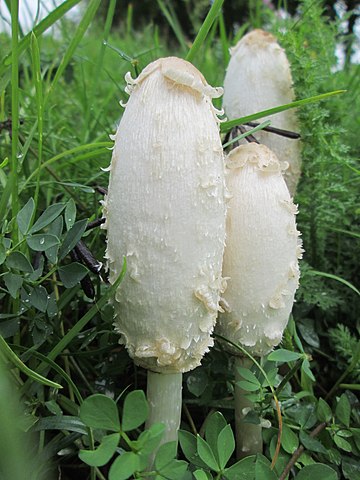
Coprinus comatus frequently grows in grasslands, fields, along gravel roads, disturbed ground, or in lawns. It is usually found in groups of several specimens.
This mushroom is often easily distinguishable. When the mushroom is young, the cap is white, oval to cylindrical, and covered with shaggy scales. As it gets older, the cap expands and gets a bell-shape and its color gradually turns darker till to almost black.
Under the cap, it has crowded gills which are free from the stem. Their color is initially white, then pinkish, and finally black once the mushroom ages.
The cap is supported by a fairly thick stipe which is hollow inside, wider at the base and tapers to apex.
Coprinus comatus is considered an edible species, before the mushroom gets older and the gills start to turn black.
8. False Parasol (Chlorophyllum Molybdites)
| Scientific Name | Chlorophyllum molybdites |
| Common Name | False parasol, green-spored Lepiota, vomiter, green gill, green-spored parasol |
| Family | Agaricaceae |
| Toxicity | Toxic |
False parasol (Chlorophyllum molybdites) is a poisonous mushroom species in the family Agaricaceae.
The false parasol is known as the most misidentified toxic mushroom in North America. The consumption of this mushroom is being reported as the most common cause of mushroom poisoning in the United States. (source)

Chlorophyllum molybdites is often found growing in forests, meadows, grasslands, parks, and is also one of the most common lawn mushrooms.
Many times, these mushrooms form small or large circular rings in grass, also known as fairy rings.
The cap of Chlorophyllum molybdites is white, first with a smooth surface, then scattered with coarse brownish scales. It has a convex to spherical shape when the mushroom is young and becomes broadly convex to almost flat when maturing.
The gills are short, crowded, free from the stipe or slightly attached. They are white when the mushroom is immature and turn grayish green to brownish green when aging.
The stem is white to brownish in color and has a smooth surface.
9. Milk-white Brittlegill (Russula Delica)
| Scientific Name | Russula delica |
| Common Name | Milk-white Brittlegill |
| Family | Russulaceae |
| Toxicity | Non-Toxic |
Milk-white brittlegill (Russula delica) is a species of white mushrooms in the family Russulaceae. It is prevalent in Europe and Asia.

Russula delica is often found growing in coniferous, broadleaf, or mixed woods and is frequently found half buried.
It has a large, white cap that is initially convex in shape, with an inrolled margin. At maturity, it flattens and many times gets a funnel shape.
On the underside of the cap, it has decurrent, pale cream, closely spaced gills.
The cap is supported by a short, white, and stout leg.
Although many sources mark this mushroom as edible, it is mostly inedible due to its poor, unpleasant taste.
10. Frosty Bonnet (Mycena Adscendens)
| Scientific Name | Mycena adscendens |
| Common Name | Frosty bonnet |
| Family | Mycenaceae |
| Toxicity | Unknown |
Frosty bonnet (Mycena adscendens) is a tiny, white mushroom in the family Mycenaceae. They are mostly found in Europe and parts of the United States.

These mushrooms are tiny, with long and thin stems that support small caps.
The caps are small, fragile, and have a white color. They initially are hood-shaped and flatten with age.
On the underside, the cap has translucent-white gills which are free from the stem or adnexed.
The stem is long, thin, hollow, translucent-white, and often curved.
The edibility of Mycena adscendens is unknown as the mushrooms are very small and insubstantial to be considered a valuable food source.
Final Word
There are many known species of white mushrooms and many other that are partially white or are white only in their early development stages and later acquire a different pigmentation.
A good example here would be the Amanitas which initially emerge like white egg-shaped mushrooms that resemble a small puffball, and then form a parasol-shaped, colored cap.
As it would have been almost impossible to talk about all the existing white mushroom species in one article, we have only included some of the most common ones in our list.
Many of them you may find growing in forests, on dead and decaying logs, on living trees, or even in your yard, garden, or lawn.
Do not identify and consume mushrooms based solely on the information presented in this article. There are many poisonous white mushrooms that can be easily confused with some of the edible species presented in the article.
Consult a mycologist before deciding if a mushroom found in the wild is safe for consumption.

